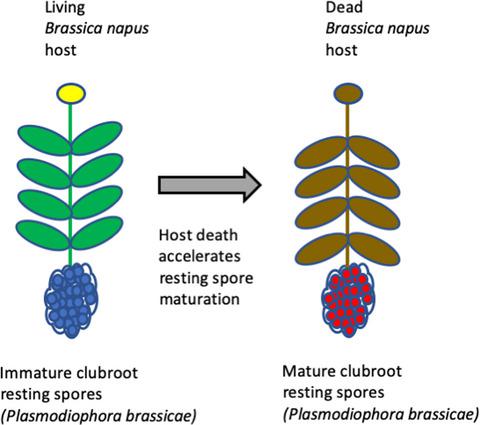当前位置:
X-MOL 学术
›
Plant Pathol.
›
论文详情
Our official English website, www.x-mol.net, welcomes your
feedback! (Note: you will need to create a separate account there.)
Maturation of resting spores of Plasmodiophora brassicae continues after host cell death
Plant Pathology ( IF 2.3 ) Pub Date : 2019-12-10 , DOI: 10.1111/ppa.13124 F. Al‐Daoud 1 , B. D. Gossen 2 , M. R. McDonald 1
Plant Pathology ( IF 2.3 ) Pub Date : 2019-12-10 , DOI: 10.1111/ppa.13124 F. Al‐Daoud 1 , B. D. Gossen 2 , M. R. McDonald 1
Affiliation

|
Plasmodiophora brassicae, cause of clubroot on canola (Brassica napus) and other Brassicaceae, is an obligate soilborne pathogen that survives in soil as long‐lived resting spores. Factors that affect the maturation of the resting spores are not well understood. To determine if a living host was required for spore maturation, experiments were conducted under controlled conditions and in field trials. Young plants with clubbed roots containing mostly immature spores had the shoots removed, or clubs were harvested at different times. To kill host cells, clubs were frozen or plants were treated with glyphosate. Clubs were then harvested from treated and non‐treated hosts and stored at low temperature (5 or 10 °C) or room temperature (22 °C). Spore concentration and maturation were assessed 2–4 weeks after treatment using propidium monoazide‐assisted quantitative PCR, and results were validated using bioassays. The state of decay of clubs was also observed to determine if it was an indicator of spore maturity. Spores continued to mature after death of host cells or removal of shoots of plants. This demonstrated that a living host was not required for spore maturation. Interestingly, killing host cells prior to storing the clubs at low temperature produced a higher proportion of mature spores and more severe clubroot in bioassays relative to non‐treated clubs held at low temperature. This indicated that death of host cells accelerates spore maturation. Furthermore, mature spores were recovered from both decayed and less decayed clubs, suggesting that club decay is not an indicator of spore maturation.
中文翻译:

寄主细胞死亡后,Plasmodiophora brasicae的静止孢子继续成熟
芸苔(Plasmodiophora brasicae),双低油菜籽上的根茎病根(甘蓝型油菜))和其他十字花科,是专性的土壤传播病原体,以长寿的静止孢子形式在土壤中生存。影响静息孢子成熟的因素尚不清楚。为了确定是否需要活的宿主进行孢子成熟,在受控条件下和田间试验中进行了实验。具棍状根的幼小植株大部分含有未成熟的孢子,将嫩芽除去,或在不同的时间收获球茎。为了杀死宿主细胞,将球茎冷冻或用草甘膦处理植物。然后从经过处理和未经处理的宿主中收获球杆,并将其储存在低温(5或10°C)或室温(22°C)下。治疗后2-4周使用单叠氮化丙啶辅助定量PCR评估孢子浓度和成熟度,并使用生物测定法验证结果。还观察到球杆的腐烂状态,以确定它是否是孢子成熟的指标。宿主细胞死亡或去除植物芽后,孢子继续成熟。这表明孢子成熟不需要活的宿主。有趣的是,与未经低温处理的球杆相比,在低温保存球杆之前杀死宿主细胞会在生物测定中产生更高比例的成熟孢子和更严重的球杆根。这表明宿主细胞的死亡加速了孢子的成熟。此外,成熟的孢子从腐烂的和腐烂程度较小的球杆中均被回收,这表明球杆的衰变并不是孢子成熟的指示。宿主细胞死亡或去除植物芽后,孢子继续成熟。这表明孢子成熟不需要活的宿主。有趣的是,与未经低温处理的球杆相比,在低温保存球杆之前杀死宿主细胞会在生物测定中产生更高比例的成熟孢子和更严重的球杆根。这表明宿主细胞的死亡加速了孢子的成熟。此外,成熟的孢子从腐烂的和腐烂程度较小的球杆中均被回收,这表明球杆的衰变并不是孢子成熟的指示。宿主细胞死亡或去除植物芽后,孢子继续成熟。这表明孢子成熟不需要活的宿主。有趣的是,与未经低温处理的球杆相比,在低温保存球杆之前杀死宿主细胞会在生物测定中产生更高比例的成熟孢子和更严重的球杆根。这表明宿主细胞的死亡加速了孢子的成熟。此外,成熟的孢子从腐烂的和腐烂程度较小的球杆中均被回收,这表明球杆的衰变并不是孢子成熟的指示。与未经处理的球杆保持在低温下相比,在低温保存球杆之前杀死宿主细胞会在生物测定中产生更高比例的成熟孢子和更严重的球根。这表明宿主细胞的死亡加速了孢子的成熟。此外,成熟的孢子从腐烂的和腐烂程度较小的球杆中均被回收,这表明球杆的衰变并不是孢子成熟的指示。与未经处理的球杆保持在低温下相比,在低温保存球杆之前杀死宿主细胞会在生物测定中产生更高比例的成熟孢子和更严重的球根。这表明宿主细胞的死亡加速了孢子的成熟。此外,成熟的孢子从腐烂的和腐烂程度较小的球杆中均被回收,这表明球杆的衰变并不是孢子成熟的指标。
更新日期:2019-12-10
中文翻译:

寄主细胞死亡后,Plasmodiophora brasicae的静止孢子继续成熟
芸苔(Plasmodiophora brasicae),双低油菜籽上的根茎病根(甘蓝型油菜))和其他十字花科,是专性的土壤传播病原体,以长寿的静止孢子形式在土壤中生存。影响静息孢子成熟的因素尚不清楚。为了确定是否需要活的宿主进行孢子成熟,在受控条件下和田间试验中进行了实验。具棍状根的幼小植株大部分含有未成熟的孢子,将嫩芽除去,或在不同的时间收获球茎。为了杀死宿主细胞,将球茎冷冻或用草甘膦处理植物。然后从经过处理和未经处理的宿主中收获球杆,并将其储存在低温(5或10°C)或室温(22°C)下。治疗后2-4周使用单叠氮化丙啶辅助定量PCR评估孢子浓度和成熟度,并使用生物测定法验证结果。还观察到球杆的腐烂状态,以确定它是否是孢子成熟的指标。宿主细胞死亡或去除植物芽后,孢子继续成熟。这表明孢子成熟不需要活的宿主。有趣的是,与未经低温处理的球杆相比,在低温保存球杆之前杀死宿主细胞会在生物测定中产生更高比例的成熟孢子和更严重的球杆根。这表明宿主细胞的死亡加速了孢子的成熟。此外,成熟的孢子从腐烂的和腐烂程度较小的球杆中均被回收,这表明球杆的衰变并不是孢子成熟的指示。宿主细胞死亡或去除植物芽后,孢子继续成熟。这表明孢子成熟不需要活的宿主。有趣的是,与未经低温处理的球杆相比,在低温保存球杆之前杀死宿主细胞会在生物测定中产生更高比例的成熟孢子和更严重的球杆根。这表明宿主细胞的死亡加速了孢子的成熟。此外,成熟的孢子从腐烂的和腐烂程度较小的球杆中均被回收,这表明球杆的衰变并不是孢子成熟的指示。宿主细胞死亡或去除植物芽后,孢子继续成熟。这表明孢子成熟不需要活的宿主。有趣的是,与未经低温处理的球杆相比,在低温保存球杆之前杀死宿主细胞会在生物测定中产生更高比例的成熟孢子和更严重的球杆根。这表明宿主细胞的死亡加速了孢子的成熟。此外,成熟的孢子从腐烂的和腐烂程度较小的球杆中均被回收,这表明球杆的衰变并不是孢子成熟的指示。与未经处理的球杆保持在低温下相比,在低温保存球杆之前杀死宿主细胞会在生物测定中产生更高比例的成熟孢子和更严重的球根。这表明宿主细胞的死亡加速了孢子的成熟。此外,成熟的孢子从腐烂的和腐烂程度较小的球杆中均被回收,这表明球杆的衰变并不是孢子成熟的指示。与未经处理的球杆保持在低温下相比,在低温保存球杆之前杀死宿主细胞会在生物测定中产生更高比例的成熟孢子和更严重的球根。这表明宿主细胞的死亡加速了孢子的成熟。此外,成熟的孢子从腐烂的和腐烂程度较小的球杆中均被回收,这表明球杆的衰变并不是孢子成熟的指标。











































 京公网安备 11010802027423号
京公网安备 11010802027423号